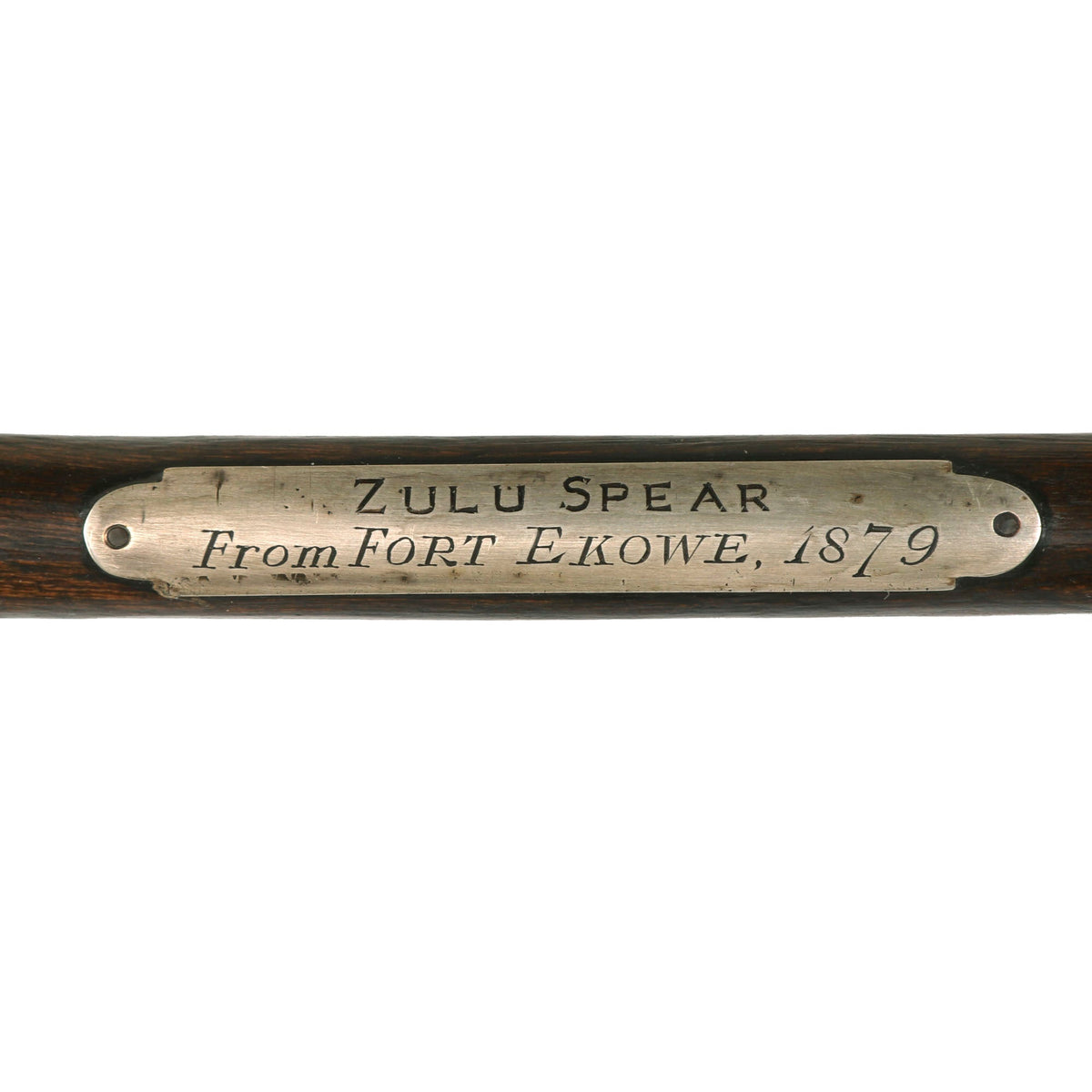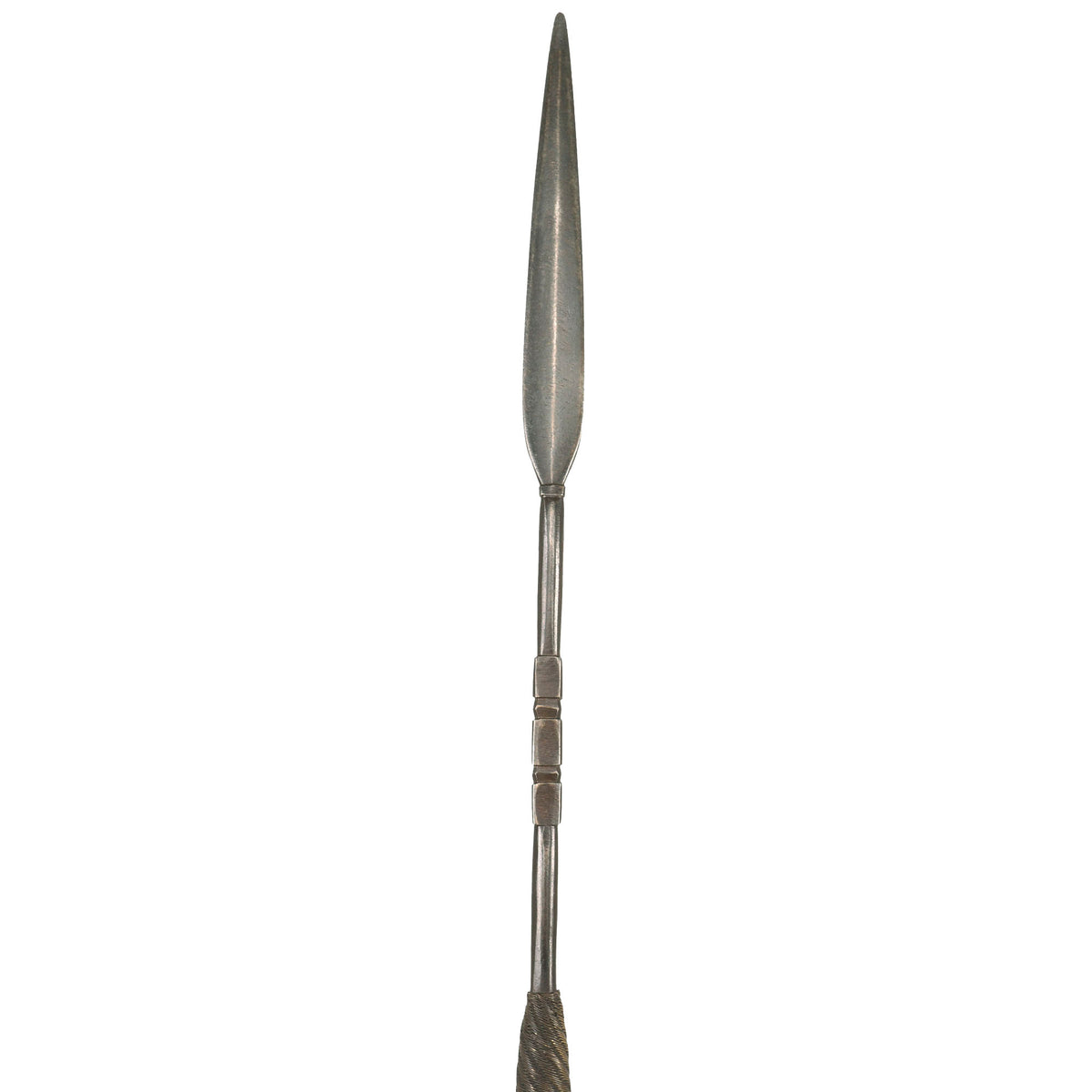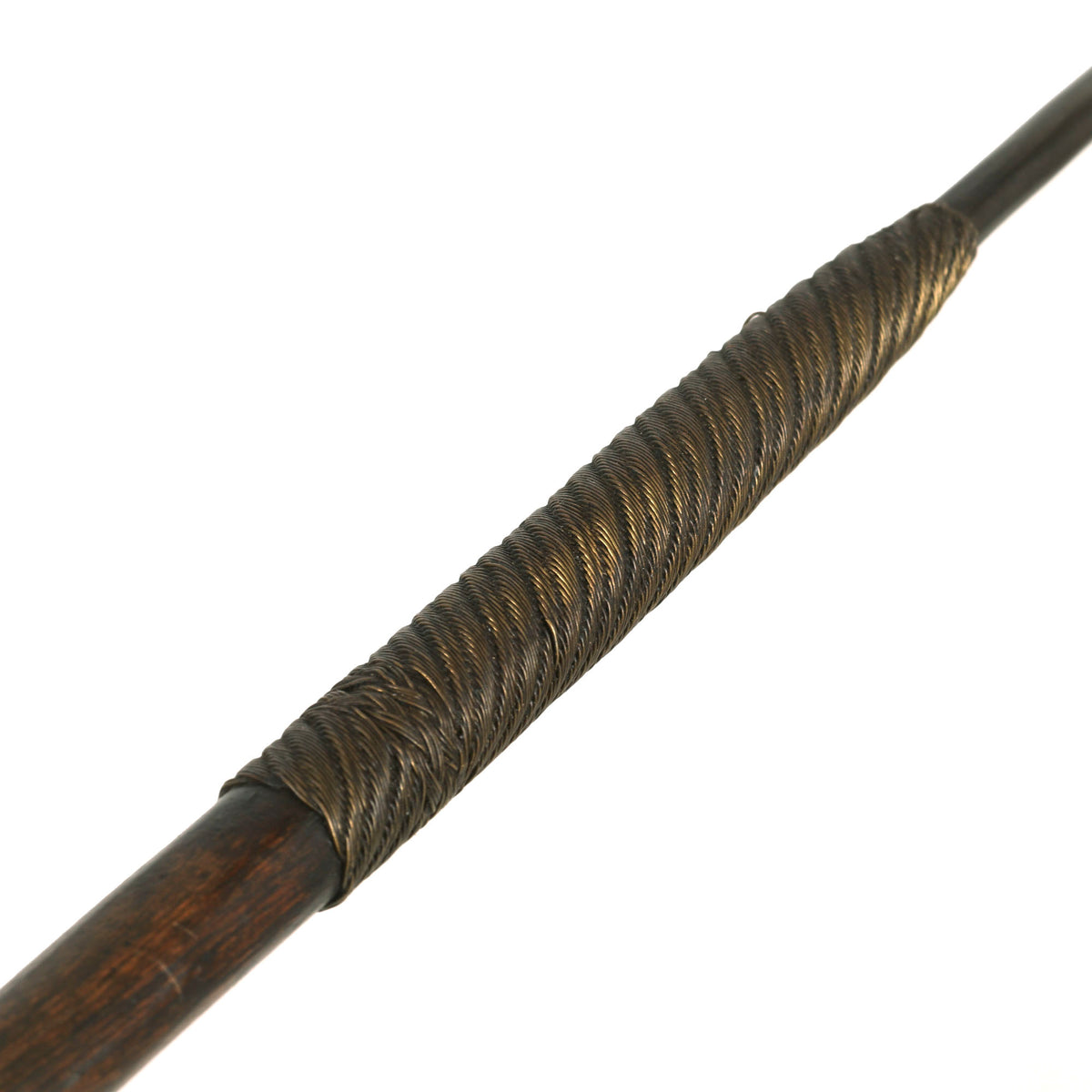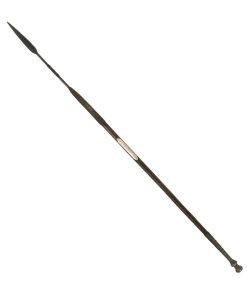Original Anglo-Zulu War Zulu Impi Throwing Spear with Plaque from Fort Ekowe 1879 Original Items
$ 1.795,00 $ 448,75
Original Item. Only One Available. This is a tremendous Zulu spear in fantastic condition that has been beautifully crafted and beset with a small plaque commemorating where it was found, in the remains of Fort Ekowe after the Siege of Eshowe in 1879. This siege was part of the ongoing Anglo-Zulu War.
The spear measures roughly 37¾”. There is a small plaque on the side of the spear reading ZULU SPEAR FROM FORT EKOWE. 1879. There are two spots at the bottom and above the plaque where the spear is wrapped beautifully with wire. The wire is in great shape minus a few spots where pieces have come undone. There are very few flaws with this piece and the plaque adds so much provenance. This spear is a great piece that will fit well into any Zulu War collection.
The Siege of Eshowe
The siege of Eshowe took place during the Anglo-Zulu War of 1879. The siege was part of a three-pronged attack on the Zulu Impis of king Cetshwayo at Ulundi. After an incursion as far as Eshowe (then also known as Fort Ekowe or kwaMondi) Colonel Charles Pearson was besieged there for two months by the Zulus.
No. 1 Column of the British invasion force, under Colonel Charles Pearson, had been ordered to establish an advanced base at Eshowe. He was to move his forces there rapidly in order to prevent the buildings from being burnt. After occupying Eshowe, Pearson was to entrench it and establish a supply base. He was to confine his operations to between Eshowe and the Tugela River until word of the other two invading columns’ progress reached him. The force crossed the Tugela from Natal into Zululand on 12 January 1879. The advance was unopposed until 22 January, when a Zulu force attempted to bar their way. The British were camped about 4 mi (6.4 km) south of the Inyezane River, which they had crossed the previous day, beneath a steep ridge with three spurs leading down towards the river and surrounded by scrub. A prominent knoll sat about halfway and there was a small kraal near the left of the crest.
Shortly after 08:00 a small number of Zulus appeared near the knoll on the ridge and a company of the Natal Native Contingent (NNC), under Lieutenant Hart, were sent up the spur after them. While this company gave chase a mass of Zulus appeared over the crest of the ridge and began pouring downwards. These men were the left “horn” of a 6,000 strong force, dispatched at the same time as the army that engaged the British at Isandlwana, who were preparing just over the crest, to attack the British camp. This left horn had been prompted into a premature attack by the advance of Lieutenant Hart’s company and in the face of this advance the NNC fled, leaving their European officers and NCOs to make a fruitless stand before being swept aside.[3] As soon as Hart and his men began firing, the camp prepared for defence, forming a hasty firing line. A naval company and two companies of Buffs with a Gatling gun and several 7-pounders moved up to the knoll, opening up across the advancing Zulu column. When the Zulus emerged from scrub and began their assault on the camp, they were subjected to massed fire from the flank and front; the Zulus wavered and then withdrew the way they had come.
While the left horn was being repulsed, the rest of the Zulu impi appeared over the crest. The kraal was taken and switching their guns to focus on it, the British force that had attacked the flank of the left horn advanced up the slope and captured the kraal. This position allowed the British to move the Gatling gun onto the crest where its rapid fire soon drove the Zulus off the centre and left end of the ridge, as the British mounted troops came up the right-hand spur to complete the action. The counter-attack resulted in 10 British killed and 16 wounded. The Zulu impi withdrew with 350 killed.
Pearson continued his march unhindered and the following day reached the mission near Eshowe at 28.892767°S 31.497075°E, 2,000 ft (610 m) above sea level. Eshowe consisted of a deserted church, school and the house of a Norwegian missionary. Low hills surrounded it about a quarter of a mile away to the north, east and west but to the south the Indian Ocean could be seen. Pearson sent a group of empty wagons with escorts to collect fresh supplies from the Lower Drift, while the rest of his force began to dig in. The next day, 24 January, bore a disturbing message for Pearson that Colonel Anthony Durnford’s No. 2 Column had been wiped out in the Middle Drift, leaving the Lower Drift behind Eshowe in grave danger. If the Zulus took the Lower Drift, Eshowe would be cut off and there would be nothing between the Zulu Army and Natal.
Two days later, Lord Chelmsford contacted Pearson. Without giving any details of the disaster at the Battle of Isandlwana he informed him that all orders were cancelled and that he was to take such as action as he thought fit to preserve his column, including withdrawal from Eshowe if necessary. If he withdrew, he was to hold the bridgehead at the Lower Drift but he might be attacked by the whole Zulu Army. Pearson had no precise information on the whereabouts of the Zulu and although his defences around the mission would soon be complete, it was not an ideal position to defend. His force had plenty of ammunition but other supplies were insufficient and the consensus of his subordinates was to pull back to the Lower Drift. The decision to stay was settled on when news arrived of the return of the supply wagons, with five further companies as reinforcement from the Lower Drift.
The fort enclosing the abandoned Norwegian Lutheran mission was roughly rectangular, 200 yd × 50 yd (183 m × 46 m), with loopholed walls 6 ft (1.8 m) high, and was surrounded by a broad ditch in which sharpened sticks were embedded. A second line of defence, should the outer rampart fall, was formed by laagering the wagons inside the walls. A horse and cattle kraal was constructed, as was an abattis; a field of fire was cleared all round out to 800 yd (730 m). The garrison numbered 1,300 soldiers and sailors, plus 400 wagoners.
The appearance of large bodies of Zulu on the surrounding hills on 2 February, although they retreated under shelling from the 7-pounders, compelled Pearson to request reinforcements. A week later, he learned for the first time the full extent of the center column’s defeat at Isandlwana and was told that there could be no reinforcement. Pearson considered withdrawing part of his garrison, if Chelmsford agreed, but receiving no response and no further runners, it became clear that Eshowe had been cut off. The garrison would run out of provisions by the beginning of April.
February passed with no Zulu attack, save for sniping attacks and skirmishes between patrols. The beginning of March led Pearson to attack a kraal 7 miles away, to keep the soldiers from idling. The next day a heliograph was spotted signaling from Fort Tenedos and a makeshift apparatus allowed Eshowe to reply. The garrison learnt that a relief force would depart the Lower Drift on 13 March and that they were to advance to the Nyezane to meet it. This was cheering news for the garrison, with rations running low and sickness having killed 20 men. As the garrison prepared to mount the planned sortie on 13 March, however, another message advised a delay in the arrival of the relief column until 1 April.
Fast Shipping with Professional Packaging
Thanks to our longstanding association with UPS FedEx DHL, and other major international carriers, we are able to provide a range of shipping options. Our warehouse staff is expertly trained and will wrap your products according to our exact and precise specifications. Prior to shipping, your goods will be thoroughly examined and securely secured. We ship to thousands clients each day across multiple countries. This shows how we're dedicated to be the largest retailer on the internet. Warehouses and distribution centres can be located throughout Europe as well as the USA.
Note: Orders with more than one item will be assigned a processing date depending on the item.
Before shipping before shipping, we'll conduct a thorough inspection of the items you have ordered. Today, the majority of orders will be delivered within 48 hours. The delivery time will be between 3-7 days.
Returns
The stock is dynamic and we cannot completely manage it because multiple stakeholders are involved, including our factory and warehouse. So the actual stock may alter at any time. It's possible that you may not receive your order once the order has been made.
Our policy is valid for a period of 30 days. If you don't receive the product within 30 days, we are not able to issue a refund or an exchange.
You can only return an item if it is unused and in the same state as the day you received it. You must have the item in its original packaging.
Related products
Uncategorized
Armored Burgonet Helmet & Polearm from Scottish Castle Leith Hall Circa 1700 Original Items
Uncategorized
Uncategorized
Uncategorized
Uncategorized
Band of Brothers ORIGINAL GERMAN WWII Le. F.H. 18 10.5cm ARTILLERY PIECE Original Items
Uncategorized
Uncategorized
Uncategorized
Uncategorized
Uncategorized
Uncategorized
Uncategorized
Uncategorized
Uncategorized
Uncategorized
Uncategorized
Uncategorized
Uncategorized
Australian WWII Owen MK1 Machine Carbine SMG Custom Fabricated Replica with Sling Original Items













































































